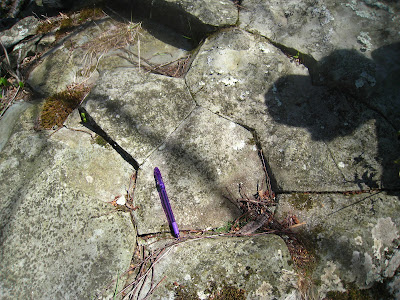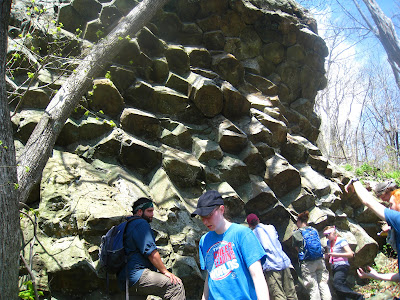Sandy Bottom Overlook
Before our class went to the third field area, we made stops to two overlooks. The first overlook was the Sandy Bottom overlook.
 |
| View from Sandy Bottom Overlook. Photo courtesy of Laura Snyder. |
Here we saw some fantastic examples of tension gashes. The gashes are quartzite and has left-lateral shear.
 |
| Tension gashes. Photo courtesy of Laura Snyder. |
Another thing that was seen was skolithos tubes viewed from the top.
 |
| Skolithos tubes. Photo courtesy of Laura Snyder. |
Franklin Hills Overlook
The second overlook was the Franklin Hills overlook. This had had rocks from the Catoctin formation. This formation was from a series of lava flows from the breakup of Rodinia from feeder dikes. Most of the Catoctin is a meta-basalt called greenstone. There is also rhyolite, meta-tuff, and metamorphosed sedimentary rocks such as- phyllite and metaconglomerate. It also has meta-volcanic breccia from lahars and epidote. In amygdules you may see milky quartz, jasper, chlorite, and zeolite minerals.
 |
| Catoctin Formation. |
Limberlost Trail
 |
| Columnar jointing at Limberlost Trial |
 |
| Class observing the outcrop. |
I took measurements of several things. One was of the angles on the face of a column- 150°, 110°, 145°, 133°, 110°, 116°, 135°. For the picture below I measured the trend and plunge of the linear triple junction- 088°,65°.
 |
| Triple Junction. |
This picture’s orientation was 090°, 59°. The angle between two columns was 65°.
 |
| Triple Junction. |
I also took the strike and dip of some joint faces-
050°, 68° and 350°, 62°.
 |
| Arrest Lines. |
Little Devil's Stairs Overlook
After we came back from the hike, we stopped at another overlook- this one called Little Devil's Stairs overlook. We saw some great examples of feeder dikes. This showed the basement complex being cute through by the Catoctin. Unakite was also present in some areas.
 |
| Catoctin feeder dike cutting through basement. |
Compton
Peak
After the stop at the overlook, we were on our way
to Compton Peak. In order to get to this
outcrop we had to go on, what I thought to be, a strenuous hike. Because I was so far behind, I arrived at the
outcrop after a majority of the people.
Unfortunately, this meant that I had less time than the others to gather
data and measurement and I missed out on the lecture. When I did arrive though, I was speechless as
to what I saw. I thought the columns at
Limberlost Trial were amazing but they couldn’t compare to those at Compton
Peak.
 |
| Basalt columns at Compton Trail. |
They were much larger, which meant that they had a slower rate of cooling. I took the orientation of some joint faces- 274°, 47°- 294°, 35°- 337°, 72°. The picture of the face is below.
 |
| Joint face. |
Here's the view looking up. The best part of the trip, hands down. I'll gladly go on the hike to see this formation again.
 |
| Basalt columns. |
No comments:
Post a Comment